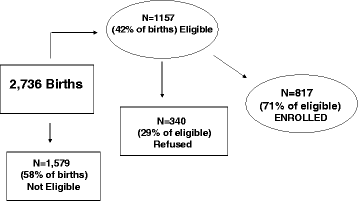Determinants of breastfeeding initiation and cessation among employed mothers: a prospective cohort study
- PMID: 27472915
- PMCID: PMC4966748
- DOI: 10.1186/s12884-016-0965-1
Determinants of breastfeeding initiation and cessation among employed mothers: a prospective cohort study
Abstract
Background: The U.S. continues to have one of the lowest breastfeeding rates in the industrialized world. Studies have shown that full-time employment and early return to work decreased breastfeeding duration, but little is known about the relationship between leave policies and breastfeeding initiation and cessation. This study aimed to identify workplace-related barriers and facilitators associated with breastfeeding initiation and cessation in the first 6 months postpartum.
Methods: A prospective cohort study design was utilized to recruit 817 Minnesota women aged 18 and older while hospitalized for childbirth. Selection criteria included English-speaking, employed mothers with a healthy, singleton birth. These women were followed up using telephone interviews at 6 weeks, 12 weeks, and 6 months after childbirth. The main study outcomes were breastfeeding initiation, measured during hospital enrollment, and breastfeeding cessation by 6 months postpartum.
Results: Women were 30 years old; 86 % were White, and 73 % were married. Breastfeeding rates were 81 % at childbirth, 67 % at 6 weeks, 49 % at 12 weeks, and 33 % at 6 months postpartum. Logistic regression revealed the odds of breastfeeding initiation were higher for women who: held professional jobs, were primiparae, had graduate degree, did not smoke prenatally, had no breastfeeding problems, and had family or friends who breastfeed. Survival analyses showed the hazard for breastfeeding cessation by 6 months was: higher for women who returned to work at any time during the 6 months postpartum versus those who did not return, lower for professional workers, higher among single than married women, higher for every educational category compared to graduate school, and higher for those with no family or friends who breastfeed.
Conclusions: While employer paid leave policy did not affect breastfeeding initiation or cessation, women who took shorter leaves were more likely to stop breastfeeding in the first 6 months postpartum. Future research should examine women's awareness of employer policies regarding paid and unpaid leave.
Keywords: Breastfeeding; Family leave policy; Postpartum; Workplace barriers.
Figures
References
-
- Council NRD. Benefits for breastfeeding. New York, NY: Natural Resource Defense Council; 2005.
-
- Centers for Disease Control and Prevention . Breastfeeding report card—United States, 2013. Atlanta, GA: Centers for Disease Control and Prevention; 2013.
-
- U.S. Department of Health and Human Services, Office of Disease Prevention and Health Promotion . Healthy People 2020. Washington, DC: U.S. Department of Health and Human Services; 2010.
Publication types
MeSH terms
Grants and funding
LinkOut - more resources
Full Text Sources
Other Literature Sources
Medical



